Medication Selector: Prazosin & Alternatives
Find Your Best Medication
Select your primary condition and preferences to see the most suitable alpha-1 blocker for you
When doctors need to lower blood pressure or relax the prostate muscle, they often reach for a drug called Prazosin - a selective alpha‑1 adrenergic blocker. It also has a niche role in easing the vivid nightmares that many people with post‑traumatic stress disorder (PTSD) experience. Because the market offers several drugs that hit similar pathways, patients and clinicians alike wonder how Prazosin really stacks up against the competition.
What makes Prazosin different?
Prazosin works by binding to alpha‑1 receptors on smooth muscle cells. When those receptors are blocked, the muscle relaxes, which widens blood vessels and reduces the resistance that the heart has to pump against. The same mechanism eases the tone of the prostate, helping men with benign prostatic hyperplasia (BPH) to urinate more easily. For PTSD, the drug dampens the brain’s over‑active stress circuits, cutting down on night‑time flashbacks.
Key attributes of Prazosin include:
- Typical oral dose: 1mg to 10mg per day, split into two or three doses.
- Half‑life: roughly 2 to 3hours, which means the drug is taken multiple times a day for steady effect.
- Common side effects: dizziness, headache, and a sudden drop in blood pressure when standing (orthostatic hypotension).
- Cost in the UK NHS: around £0.30 per tablet, making it a relatively inexpensive option.
Big players that sit in the same space
Several other medications target the alpha‑1 pathway or achieve a similar blood‑pressure‑lowering effect. The most frequently mentioned alternatives are Doxazosin - another selective alpha‑1 blocker, Terazosin - a long‑acting alpha‑1 blocker, and the vasodilator Hydralazine - a direct smooth‑muscle relaxant. Clinicians sometimes also consider Clonidine - an alpha‑2 adrenergic agonist that lowers blood pressure by reducing sympathetic outflow, especially when a patient cannot tolerate alpha‑1 blockers.
All these drugs share the goal of easing vascular tension, but they differ in dosing convenience, side‑effect profile, and the conditions they’re approved for.
Side‑by‑side comparison
| Drug | Primary Uses | Typical Dose Range | Half‑Life | Common Side Effects | Approx. UK Cost (per tablet) |
|---|---|---|---|---|---|
| Prazosin | Hypertension, BPH, PTSD nightmares | 1‑10mg daily (split) | 2‑3hours | Dizziness, orthostatic hypotension, headache | £0.30 |
| Doxazosin | Hypertension, BPH | 1‑16mg daily | 16‑30hours | Fatigue, swelling, dizziness | £0.45 |
| Terazosin | Hypertension, BPH | 1‑10mg daily | 12‑24hours | Dizziness, headache, nasal congestion | £0.40 |
| Hydralazine | Hypertension (often in combination) | 10‑100mg daily (divided) | 2‑4hours | Flushing, tachycardia, lupus‑like syndrome | £0.25 |
| Clonidine | Hypertension, ADHD, opioid withdrawal | 0.1‑0.3mg twice daily | 12‑16hours | Dry mouth, sedation, rebound hypertension | £0.35 |
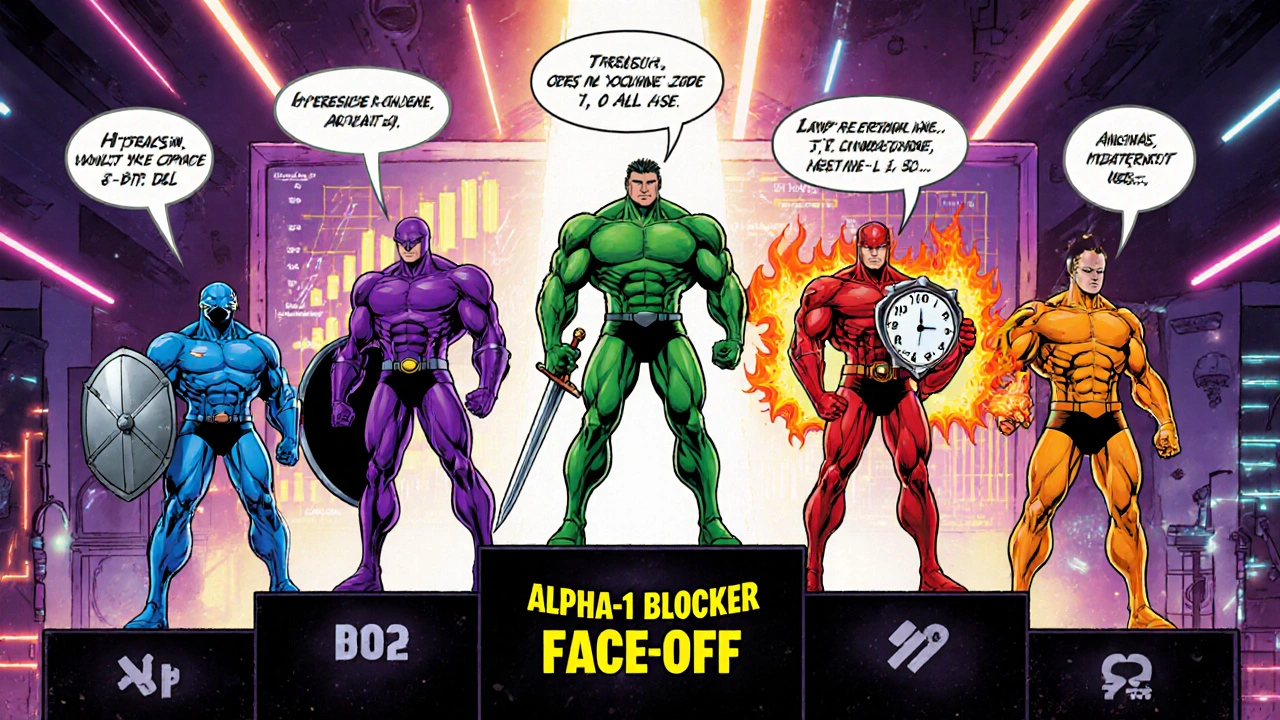
Choosing the right drug for you
If your main problem is classic high blood pressure and you prefer once‑daily dosing, Doxazosin or Terazosin can be gentler because they stay in the bloodstream longer. Their longer half‑life means you often only need one pill a day, which many patients find easier to remember.
For men whose primary complaint is urinary trouble from BPH, all three alpha‑1 blockers work, but Doxazosin tends to cause less sexual dysfunction than Prazosin, according to a 2023 UK urology survey.
When it comes to PTSD‑related nightmares, the evidence still favors Prazosin. Multiple randomized controlled trials have shown it reduces the frequency of trauma‑related dreams, and the drug is widely recommended in UK mental‑health guidelines.
If you’re already on multiple blood‑pressure meds and need a quick‑acting vasodilator, Hydralazine can be added, but you’ll have to watch for a rapid heart rate and the rare lupus‑like reaction.
Finally, for patients who cannot tolerate the drop in standing blood pressure that alpha‑1 blockers sometimes cause, Clonidine offers a different pathway-lowering sympathetic nerve activity rather than blocking receptors directly.
Safety and interaction tips
- Never combine two alpha‑1 blockers (e.g., Prazosin + Doxazosin) without specialist supervision-they can cause severe hypotension.
- Watch out for CYP3A4 inhibitors (like erythromycin or grapefruit juice) which can raise levels of Prazosin, Doxazosin, and Terazosin.
- Patients with severe liver disease should avoid high doses of Hydralazine because the drug is metabolized hepatically.
- Clonidine should be tapered off gradually; stopping suddenly can trigger a rebound spike in blood pressure.
- Pregnant or breastfeeding women need a doctor’s clearance for any of these medicines; data are limited.
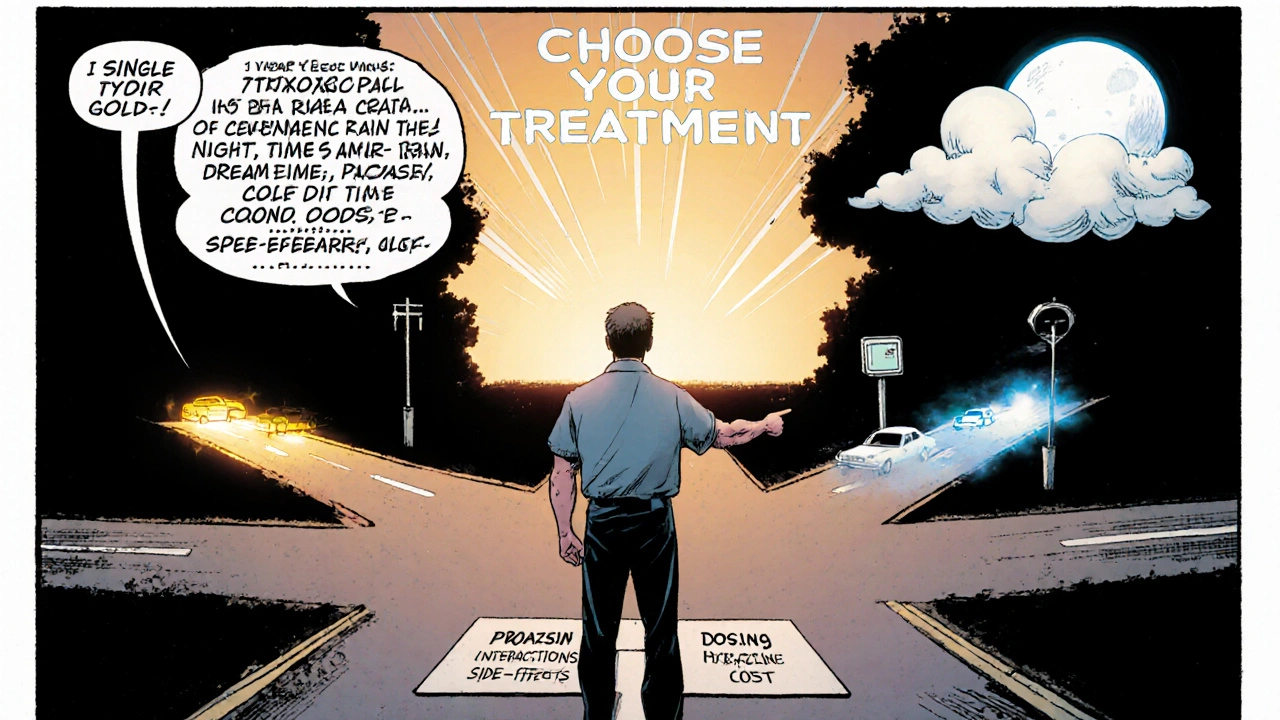
Quick checklist before you switch
- Identify the primary condition you’re treating (BP, BPH, PTSD).
- Check the dosing frequency you can stick to.
- Review any current meds for CYP3A4 interactions.
- Consider side‑effect tolerance-do you mind dizziness versus flushing?
- Discuss cost with your pharmacist; most NHS prescriptions are standard charge, but some brands have generic versions.
- Confirm with your GP or specialist that the switch is clinically appropriate.
Frequently Asked Questions
Can I take Prazosin and Doxazosin together?
No. Using two alpha‑1 blockers at the same time can cause a dangerous drop in blood pressure. If one isn’t working, your doctor may switch you to the other, but they shouldn’t be combined.
Is Prazosin effective for PTSD nightmares?
Yes. Several UK and US studies have shown that low‑dose Prazosin reduces the frequency and intensity of trauma‑related dreams in many patients.
What’s the biggest side effect of Hydralazine?
The most common complaint is flushing and a fast heartbeat. A rare but serious reaction mimicking lupus can also occur, so doctors monitor blood tests periodically.
Do I need to take Prazosin at night?
Many clinicians split the dose, with one tablet taken at bedtime to help with PTSD nightmares. The other dose(s) are usually in the morning and early afternoon to control blood pressure.
Is there a generic version of Terazosin?
Yes. The NHS provides a low‑cost generic form of Terazosin, which is chemically identical to the brand version.
Can Clonidine be used for BPH?
No. Clonidine works on a different receptor (alpha‑2) and does not relax the prostate muscle, so it isn’t indicated for BPH.
Next steps
Talk to your GP or a specialist pharmacist. Bring this comparison sheet, note which condition matters most to you, and ask about any drug‑drug interactions with your current meds. With the right information, you’ll land on the medication that best balances effectiveness, side‑effects, and cost.
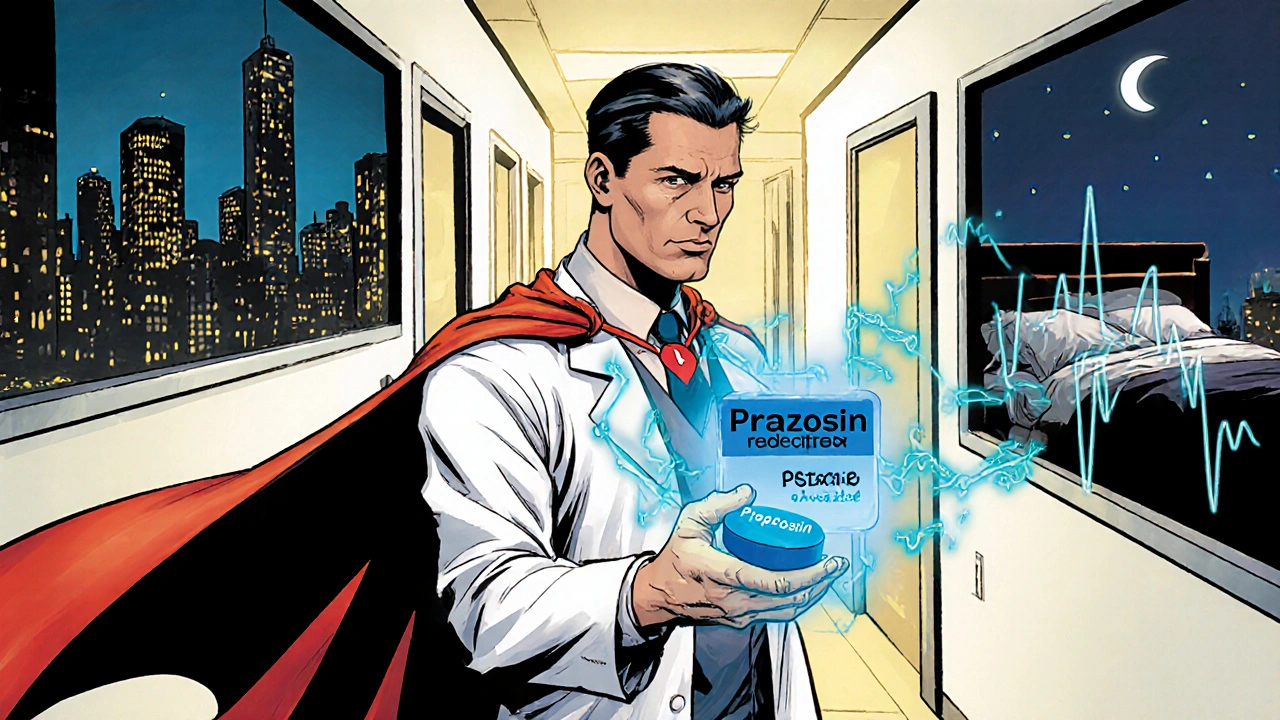
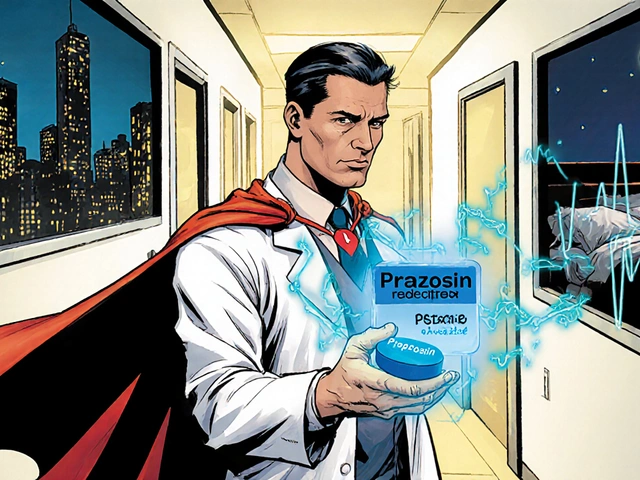
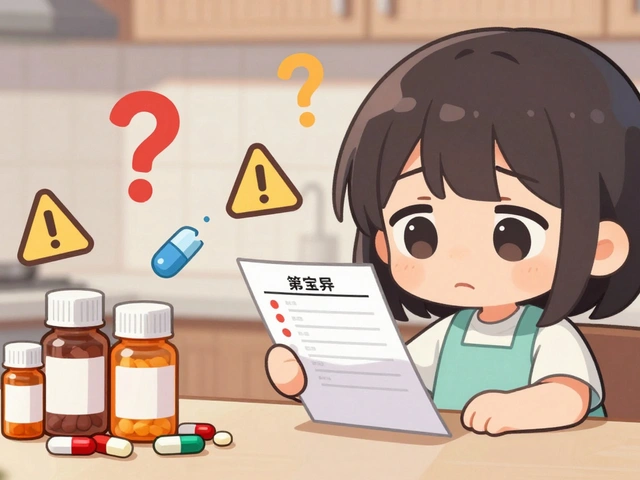
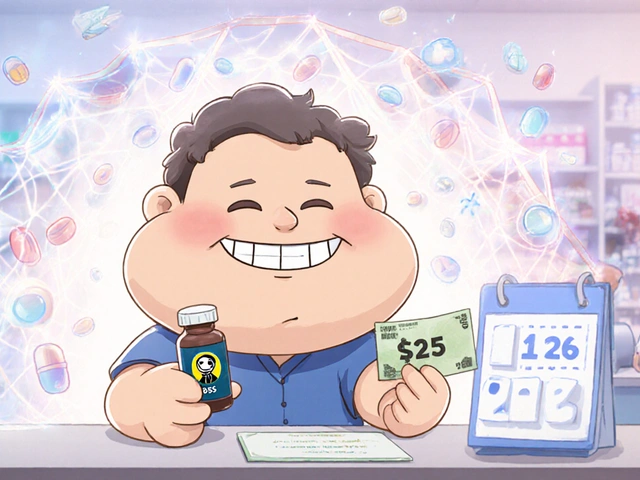

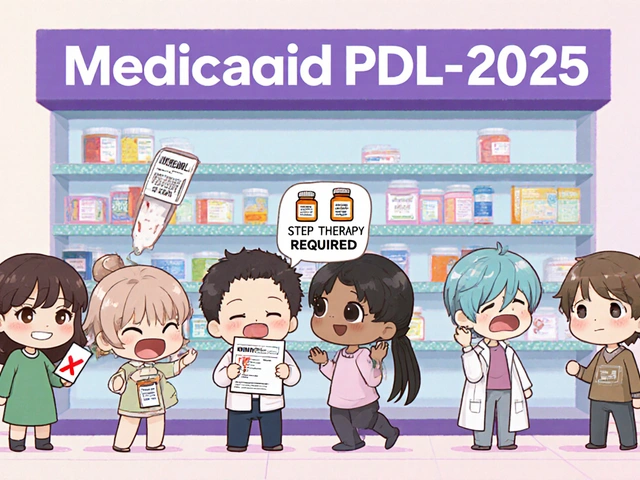

Darryl Gates
October 16, 2025 AT 18:33Great rundown, really helps anyone trying to pick the right alpha‑1 blocker.
You've laid out the dosing and cost clearly, which is often the hardest part for patients.
The side‑effect comparison is spot on, especially the orthostatic hypotension warning.
I appreciate the practical checklist at the end – it gives a clear action plan.
Overall, a solid resource for both clinicians and patients.
Frank Diaz
October 27, 2025 AT 03:33The market’s obsession with chemical tinkering is nothing short of a modern alchemy, turning profit into prescription.
While the data you present are thorough, they mask the deeper issue of pharmaceutical gatekeeping.
Every tablet represents a contract with an industry that prioritizes shareholder returns over true therapeutic nuance.
One could argue that the “choice” offered by doxazosin versus prazosin is a manufactured illusion.
Nevertheless, the clinical distinctions you note remain valid within that constrained framework.
In the end, patients are left navigating a maze designed by those who profit from their confusion.
Mary Davies
November 5, 2025 AT 23:39The way you laid out the side‑effects feels like a dramatic theater, each drug taking its cue on stage.
It’s almost poetic how the nightmare‑relief of prazosin steals the spotlight from the bland safety of terazosin.
Still, the underlying message is clear: choose the actor that fits your script.
Carissa Padilha
November 15, 2025 AT 05:53The pharmaceutical narrative presented in the article is just the tip of an iceberg that most patients never see.
Behind every generic tablet lies a labyrinth of patents, lobbying, and covert agreements that shape prescribing habits.
It is no coincidence that the drug with the lowest cost per tablet, prazosin, also happens to be the oldest on the market, having been repurposed from hypertension to PTSD without a fanfare.
The so‑called “clinical superiority” of prazosin for nightmares is often amplified by a network of clinicians who have received speaker fees for promoting off‑label uses.
Meanwhile, newer agents like doxazosin receive glossy marketing campaigns that drown out the quiet, hard‑won evidence in journals.
The half‑life differences you listed are not just pharmacokinetic facts but also mechanisms by which companies can price dosing schedules to maximize profit.
A longer half‑life means fewer pills, which translates to lower per‑prescription revenue, so the push for once‑daily drugs is subtly backed by insurers with hidden rebates.
On the other hand, the rapid onset of hydralazine makes it a perfect candidate for “bridge therapy” that keeps patients in the care loop longer.
The warning you give about CYP3A4 inhibitors is critical, yet many prescribers overlook it because their electronic health records are calibrated to flag only the most common drug interactions, deliberately leaving obscure pathways unchecked.
The conspiratorial whisper that “the government knows more than they tell us” often has a grain of truth when you consider the secret agreements between the NHS and pharmaceutical firms that dictate formulary inclusion.
In practice, a GP might be nudged toward prescribing a drug that the NHS has a contract with, regardless of the nuanced patient profile you detailed.
The checklist at the end is a brilliant façade of empowerment, but it also subtly reinforces the narrative that the burden of decision lies entirely on the patient.
This shifts responsibility away from a system that controls drug availability, pricing, and even the research agenda.
Ultimately, the choice between prazosin and its alternatives is less about pure pharmacology and more about which corporate sponsor’s lobbyist you happen to cross paths with at a conference.
So, while the table you provided is factually correct, reading it through a lens of suspicion reveals a deeper story about control, profit, and the invisible hands that steer medical practice.
Richard O'Callaghan
November 23, 2025 AT 22:13I alwasy think doctors just push cheap pills without real care.
Alexis Howard
December 2, 2025 AT 00:39yeah its ok but i dont see the big diff
Malia Rivera
December 9, 2025 AT 13:13From a patriotic standpoint, we should champion home‑grown research rather than rely on imported pharma narratives.
The data you compiled is decent but feels like a rehash of Western studies that ignore local population nuances.
Still, the pragmatic approach you suggest-matching drug to primary condition-aligns with common‑sense medicine.
Let’s keep the conversation going, because informed patients are the true defenders of our health sovereignty.